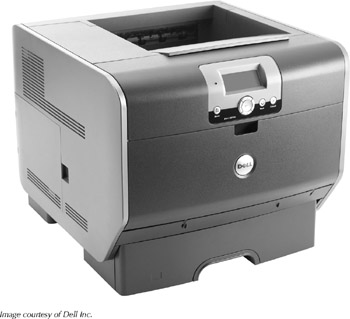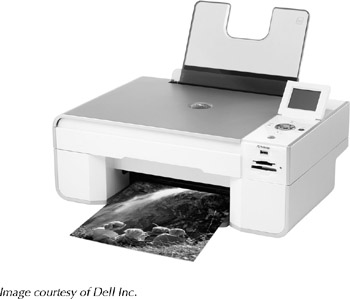Chapter 35: Printing from Your Computer
There used to be talk, as computers started to become more popular, that paper and printed objects would become obsolete. Well, computers are more popular than ever and the sale of printers is as strong as ever. The printed page is familiar and comfortable, so you can expect it to be around for some time.
Printers come in many different types. Some are better for printing text and some are better at printing photographs, but all printers connect to the computer and access data files in pretty much the same way.
Understanding how printers work helps keep them working well and available when you need them. This chapter covers all the details you need about printers to use them effectively.
Understanding Printer Types
There are several different types of printers that you can choose from. The one you choose depends on the type of printing you need to do. Some printers are relatively easy to use but limited in the number of pages they can print. Other printers, such as those for offices, can handle large print jobs without having to be refilled with paper or toner as often. Some printers specialize in specific types of documents such as photographs. The technology used to print pages differs with each of these printer types.
Laser printers
Laser printers produce the crispest, cleanest results; they are also among the fastest type of printer, but they can also be the most expensive type of printer. Some time ago, laser printers could print only in black and white, but color laser printers are now available and reasonably priced, making it possible for anyone to print crisp, clean color pages.
Laser printers include a drum cylinder that is initially positively charged with an electrostatic charge. The data sent to the printer is used to control a fine laser light that discharges the areas on the drum where the ink should be. The drum is exposed to the toner, which is like fine powder. This ink sticks to the areas of the drum that are now negatively charged. A page of paper is rolled under the drum, and some heated rollers melt the ink to the page where it is permanently affixed.
Several different manufacturers produce laser printers, including Brother, Hewlett-Packard, Samsung, and Lexmark. Figure 35.1 shows the Dell 5310n laser printer.

Figure 35.1: Laser printers are quiet, fast, and available in versions that can print in monochrome or color.
The advantages of buying a laser printer are that they operate quietly and print fairly quickly. Laser printed pages also don't have the problem common with inkjet pages of smearing ink that gets rubbed. Ink cartridges for laser printers can be expensive, but they typically last a long time.
| Note | When considering which printer to buy, you should consider the cost per page, which factors in the initial cost of the printer, the cost of the paper, and ink supplies. Even though laser printers and their ink cartridges are more expensive, they generally have a lower overall cost per page than inkjet printers. |
Inkjet printers
Inkjet printers work by spraying ink onto the paper. Inkjet printers are much cheaper than laser printers, but the results can be fuzzy and blurry when printed on normal paper. This can be improved if you use the inkjet printer with a specialized glossy paper.
| Note | Newer technologies have greatly improved the quality of inkjet printers in recent years, but many people still consider them inferior to laser printers. |
Even though inkjet printers are fairly inexpensive, they use a lot of ink and their ink cartridges run out fairly quickly. Inkjet printers use two different ink cartridges: a color cartridge that includes magenta, cyan, and yellow ink, and a separate cartridge that holds black ink.
Mixing the three primary ink colors together in differing amounts produces a wide range of colors. However, if you use one color more than the others, then that color may run out before the others, requiring a new color cartridge. Mixing all three colors together can create black, but without the extra black ink cartridge this actually results in a muddy brown color instead of dark black. It also uses three times the amount of ink than just using the black cartridge.
| Tip | Many companies help reduce the cost of purchasing new cartridges by offering the ability to refill the existing cartridges. |
Inkjet printers are also very slow. They work by printing the image in strips, and the ink can smear if they get rubbed soon after being printed.
Impact printers
Impact printers, which are often called dot-matrix printers, work by striking a metal head or pin against a page of paper with an ink ribbon in-between. The result creates a small dot on the page. By controlling the position of the printer head, you can precisely print to a page.
Older impact printers have heads made from 9 pins, but 24-pin heads are also available. The more pins on the head of an impact printer, the better its resolution.
Impact printers are older technology, but they have the advantage of being able to print onto multiple-sheet pages like receipts. One of their major drawbacks is the noise they create. Replacement ink ribbons for impact printers are relatively cheap when compared to inkjet or laser printer cartridges. The quality of impact printers is also inferior to laser and inkjet printers.
Photo printers
You can use photo printers with digital cameras to print photographs that are similar to those produced by a photo lab. However, photo printers are specialized and cannot be used to print data files such as text documents.
There are several different technologies used to print photos. One photo printer technology works just like inkjet printers by combining and spraying dots of ink on the page. These photo printers work best when combined with specialized photo paper that more effectively captures the ink. Photo printers that use this technology also use six unique color cartridges instead of the typical three, including light cyan, light magenta, cyan, magenta, yellow, and black. Using six colors gives a much broader color range.
Other photo printers use a dye sublimation process, which involves melting and combining solid ink blocks together to create the image's colors.
Photo printers can print high-quality images that are comparable to photographs, but the cost is still fairly expensive, equating to roughly 20–40 cents per print. These printers are not very good at printing documents that include a lot of text. Photo printer cartridges are very expensive when compared to inkjet and laser printers, but the quality is excellent.
Some photo printers include slots that allow you to insert a flash memory card directly into the printer and print without connecting the printer to a computer. These printers also include a small LCD screen where you can preview, edit, and even crop the photos before printing them. Figure 35.2 shows a popular Dell photo printer.

Figure 35.2: Some photo printers allow you to print directly from a flash memory card without connecting to a computer.
| Note | As an alternative to buying a photo printer, many department and drug stores offer photo printing kiosks that accept memory cards. |
All-in-Ones (printer/scanner/copier/fax)
If you purchase a printer, a fax machine, and a flatbed scanner separately, they can take up a lot of desk space. You can resolve this issue by getting an All-in-One device that can work as a printer, scanner, copier, and fax machine.
| CROSS-REF | You can learn more about scanning in Chapter 37 and more about faxing in Chapter 45. |
A printer and scanner combined into a single unit can act as a copier without requiring a computer.
The key benefit of these All-in-Ones is cost. A single unit that can print, scan, fax, and copy is much cheaper than buying each individually. These units have the ability to use inkjet or laser technology. The drawback to these units is that they can be complicated. If you never plan on using the fax features, then all the extra buttons may be confusing.
EAN: 2147483647
Pages: 372